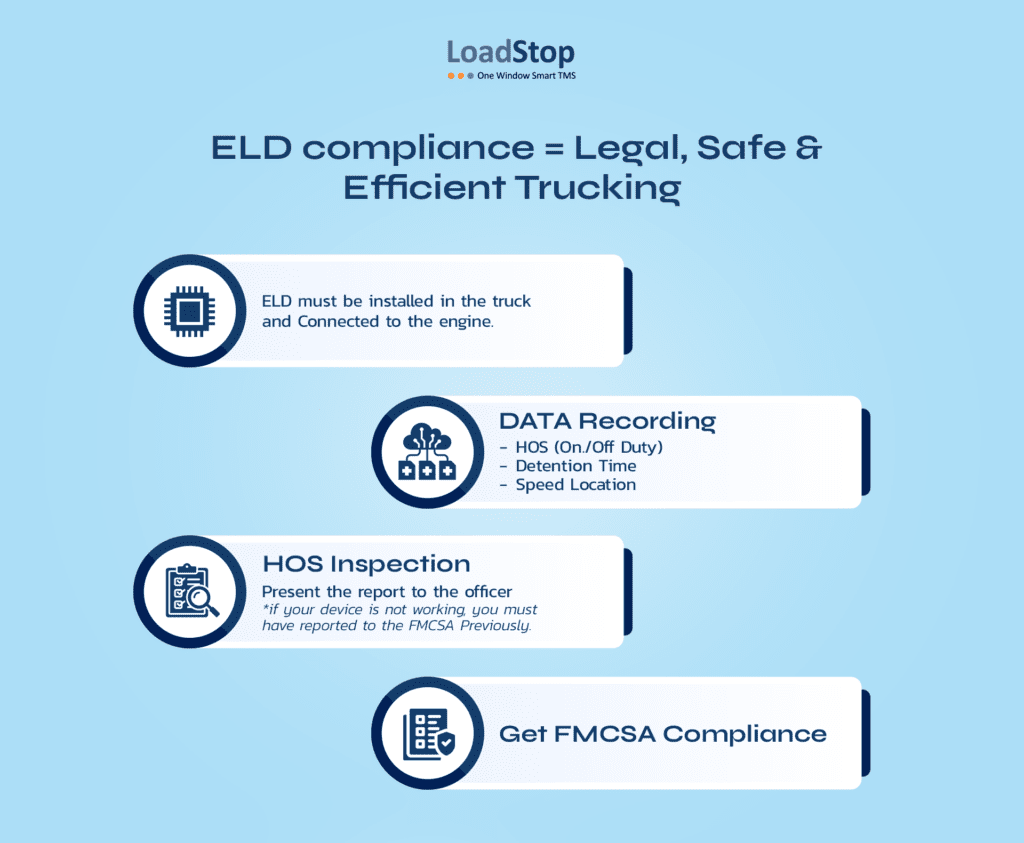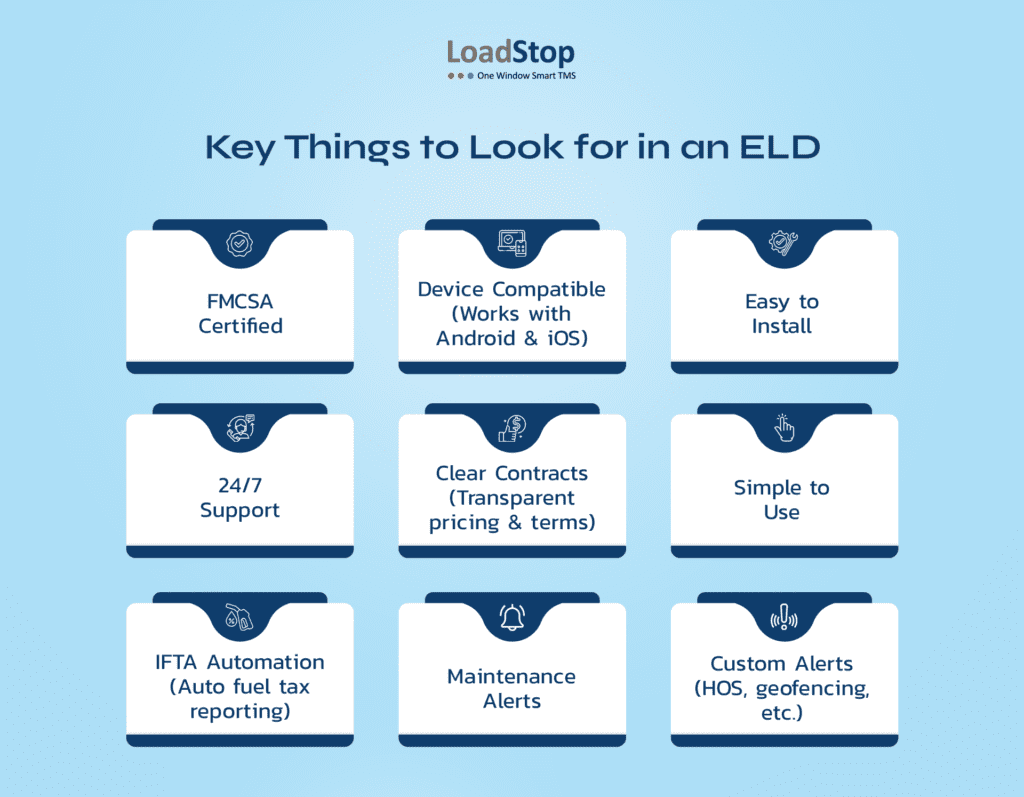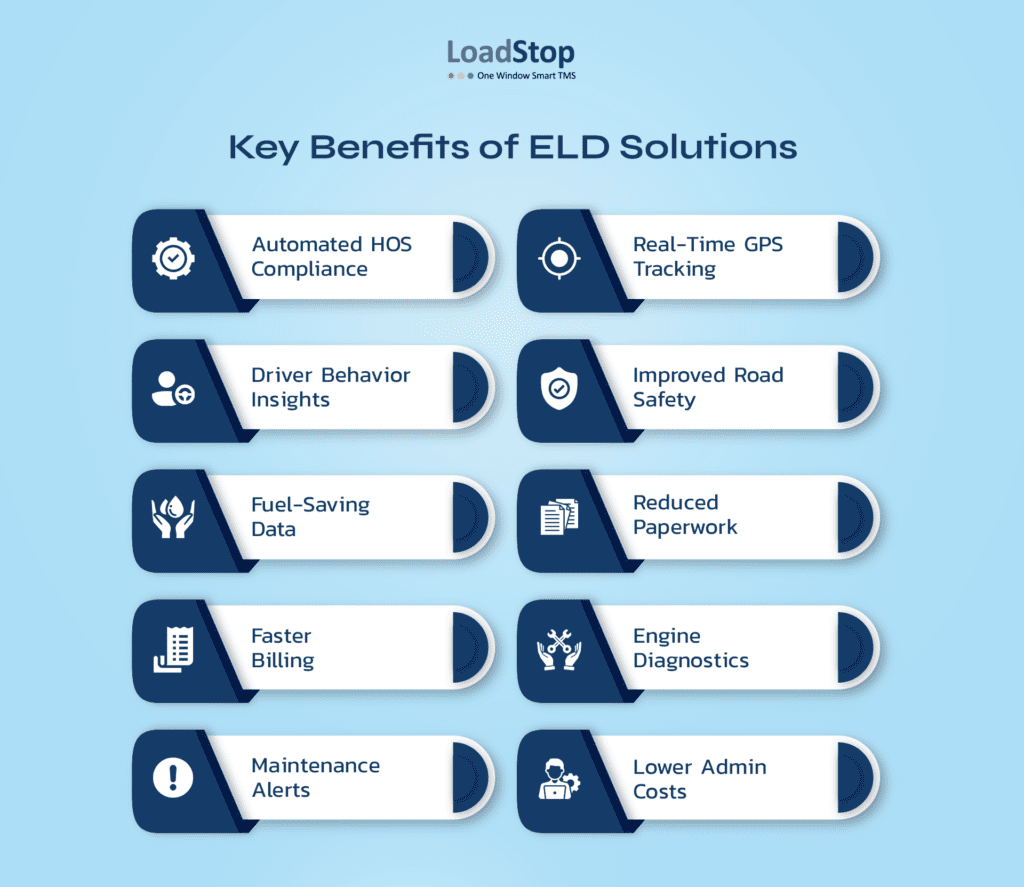Have you ever faced a straightforward logging error recently caused one of your top drivers to be delayed? Dispatch is rushing to make adjustments, compliance is eroding, and the paperwork is in disarray. Does that sound familiar? Electronic Logging Devices (ELDs) are useful in this situation. By automatically recording a driver’s Hours of Service (HOS), an ELD replaces antiquated paper logs and assists fleets in adhering to FMCSA standards.
ELDs are vital tools for streamlining operations in the fast-paced trucking sector of today, and they are not only about compliance. According to the FMCSA, carriers using ELDs have reported a 50% drop in HOS violations.
However, when ELDs are combined with a potent Transportation Management System (TMS), the real game-changer occurs. Real-time tracking, automatic reporting, and more intelligent dispatch choices are made possible by this combination.
LoadStop excels in this situation. As a cutting-edge TMS designed for today’s fleets, provides smooth ELD integration with top suppliers, making compliance easier, lowering downtime, and ensuring your trucks are operating efficiently. Before we jump any deeper, let’s develop a better understanding of it.
What is an ELD and why is it mandatory?
To automatically record a driver’s Hours of Service (HOS), commercial motor vehicles are equipped with electronic devices called Electronic Logging Devices (ELDs). The aim is to reduce fatigue and improve road safety, its primary goal is to make sure drivers are adhering to federally mandated work restrictions. ELDs provide real-time, impenetrable records of driving time, rest periods, and duty status since they can record data straight from the vehicle’s engine, unlike conventional paper logs.

The ELD requirement was implemented by the Federal Motor Carrier Safety Administration (FMCSA) as part of a larger effort to increase traffic safety and make it easier for drivers and carriers to comply. Most commercial drivers who must maintain RODS (Records of Duty Status) must utilize an ELD registered with the FMCSA, according to the rule, which went into full force in December 2019.
There are severe repercussions if the ELD mandate is not followed. A carrier’s reputation and contract eligibility may be impacted by penalties such as out-of-service orders, fines ranging from hundreds to thousands of dollars per infraction, and low CSA (Compliance, Safety, Accountability) scores. To put it briefly, maintaining compliance with the ELD rule is necessary for operating a trucking business in a way that is safe, legal, and effective.
How does an ELD for trucks work?
Under the FMCSA’s ELD mandate, truckers are required to record several parameters related to the driver and the truck itself.
After initially synchronizing with the car’s engine, an ELD records the following crucial details:
- Status of engine power (on/off)
- Engine hours, speed, and miles driven
- Remaining fuel
- Status of truck motion
The driver’s conduct, HOS, and duty status (on-duty or off-duty) are among the other details the ELD logs. Drivers have the option to add remarks or recommendations to their entries. Safety officials review this information to ensure fleets promote safe working conditions for their employees and, by extension, other drivers on the road.
Things to consider when choosing an ELD solution
Examine the available options and take into account the unique issues of your fleet when choosing an ELD for the trucks in it. What suits one fleet might not suit another.

Using high-quality industrial oil is critical for preserving fleet performance and minimizing engine wear, just as choosing the appropriate ELD is critical for efficiency and compliance.
The following are important characteristics of the top ELDs for trucks:
- Certification: In order to adhere to FMCSA standards, ELDs need to be certified.
- Make sure the ELD software you select is compatible with your Android or Apple devices.
- Customer service: The top ELDs provide round-the-clock customer service to assist with any issues.
- Easy installation: Before you even begin putting the ELD software into practice, it should be easy to install.
- Terms and conditions of the contract: You must carefully go over and compare the terms of the ELD software, including the pricing, with those on your shortlist.
- Integration by intuition: The ELD software should be simple to use after a brief learning curve, from maintaining compliance to integrating it with other important fleet management systems to guaranteeing employee safety.
- Automated IFTA reporting: Certain ELDs have the ability to compute fuel tax reports automatically, which saves time and lowers errors.
- System alerts: Advanced ELDs can provide maintenance notifications and engine problem codes for vehicles.
- Integration capabilities: Your current fleet management software and the ELD should work together flawlessly.
- Personalized alerts: Seek out technologies that let you customize alerts for things like geofence breaches or HOS infractions.
In certain situations, the advanced features that a specific ELD firm offers may influence your ultimate choice. Simple additions like a touchscreen or voice command can enhance the user experience. For instance, the ability to shorten your fuel tax reporting procedures by simplifying IFTA mileage computations can be really helpful.
TMS and ELD integration: What to expect
Software called a Transportation Management System (TMS) aids carriers and logistics firms in organizing, carrying out, and optimizing the transportation of goods. Everything is managed on a single, centralized platform, including load tracking, dispatching, and route planning.
A robust, interconnected ecosystem that does away with manual data entry and lowers the possibility of human mistakes is produced when a TMS combines with an ELD system.
How integrated platforms reduce errors and improve dispatch
Data automatically moves between your ELD system and TMS once they are integrated. In addition to ensuring dispatchers have real-time insights into driver availability, HOS limitations, and vehicle location, this also removes inaccuracies associated with manual entry. The outcome? Route optimization, fewer infractions, and quicker dispatch decisions—all predicated on precise, current data.
Automation of reporting and alerts
Real-time notifications and automated compliance reporting are also made possible by integrated systems. Without having to do anything, fleet managers have fast access to driver logs, trip summaries, and violation risks. Custom alerts keep your fleet efficient, safe, and compliant by preventing HOS violations or neglected maintenance.
Platforms like LoadStop offer smooth TMS and ELD connectivity that streamlines fleet administration in every way, allowing you to concentrate more on expansion rather than speculation.
How ELDs help with Hours of Service (HOS) compliance
Overview of HOS rules
The FMCSA established the federal Hours of Service (HOS) requirements to avoid driver fatigue and maintain road safety. Important guidelines consist of:
- After ten hours off duty in a row, a maximum of eleven hours of driving
- A maximum of 14 hours of daily on-duty
- After eight hours of driving, 30-minute breaks are required.
- A 60/70-hour cap for seven or eight days in a row
Real-time tracking of drive time
By automatically documenting driving hours, rest intervals, and duty statuses, ELDs make HOS compliance easier. The gadget precisely tracks time by syncing with the truck’s engine rather than using handwritten logs. This gives fleet management and drivers access to real-time data on how long it will be until a break or shift reset is necessary.
Automatic alerts for violation prevention
The capacity of ELDs to provide real-time alerts for impending HOS infractions is a significant advantage. The technology alerts the user when a motorist is about to exceed the 11-hour limit or has missed a break, allowing them to take prompt action and reducing the possibility of expensive fines and safety hazards.
Key benefits of ELD solutions for trucks
ELDs provide accurate data that helps fleets improve safety, cut expenses, and make better decisions overall. They go beyond simple logkeeping. The following are some of the most significant advantages that ELD systems offer fleet operations:

Improved compliance with Hours of Service (HOS) rules
By immediately synchronizing with the vehicle’s engine, ELDs automate the logging of HOS data, doing away with manual entry and lowering the possibility of fabricated logs. This lowers audit risks, guarantees constant adherence to FMCSA standards, and assists fleets in avoiding expensive non-compliance penalties. Dispatchers may more effectively schedule loads without running the risk of driver tiredness or infractions when they have real-time access to HOS data.
Real-time tracking and driver behavior monitoring
Live GPS tracking and analytics on driver behavior, including forceful braking, acceleration, speeding, and idling, are features of contemporary ELD systems. Fleet managers may coach drivers, raise safety ratings, and lower liability risk by using the actionable knowledge they obtain about driving behaviors. These insights are also essential for DOT inspections and insurance risk assessments.
Better fuel efficiency and reduced paperwork
ELDs assist fleets in identifying fuel-wasting behaviors and optimizing routes by recording idle time data and engine diagnostics. They also remove the need for trip sheets, DVIRs (Driver Vehicle Inspection Reports), and manual logs, which speeds up back-office and billing processes while lowering administrative costs and human error.
Accurate vehicle diagnostics and maintenance alerts
Onboard diagnostic systems (OBD-II) and ELDs frequently integrate, allowing for real-time vehicle health monitoring. This minimizes downtime from unforeseen repairs and enables proactive maintenance scheduling. It also features automatic notifications for engine issues, maintenance reminders, and inspection readiness.
Why LoadStop is your best partner for ELD integration
ELDs are now essential for modern fleets due to their ability to reduce operational overhead, improve safety, and minimize HOS violations. However, in order to fully realize their potential, ELDs must collaborate with your TMS, which is where LoadStop excels.
With its smooth ELD interface with leading FMCSA-certified providers, LoadStop facilitates a two-way data flow that does away with manual procedures and optimizes fleet management from start to finish. LoadStop automatically records and centralizes all of your data, whether you’re tracking driver hours, keeping an eye on car problems, or examining fuel consumption.
Fleet managers have access to dashboards that can be customized and include GPS tracking, driver performance analytics, and real-time HOS notifications. You can act quickly, improve routes, and guarantee compliance from a single platform thanks to LoadStop’s user-friendly interface.
Don’t Just Manage—Master Your Fleet.
FAQs
Integrating ELD with LoadStop’s TMS gives you real-time access to driver logs, HOS compliance, and vehicle data, all in one place. It eliminates manual data entry, reduces errors, and streamlines dispatching, compliance, and reporting.
With real-time alerts, automated reporting, and visual dashboards, LoadStop notifies fleet managers and drivers before any potential HOS violations occur—helping you stay ahead of compliance issues.
Not at all. LoadStop is built for easy, plug-and-play ELD integration with minimal downtime. Our support team works closely with your fleet to connect your existing ELD provider, configure data syncing, and customize your dashboard—so you’re up and running in no time, without disrupting your operations.



